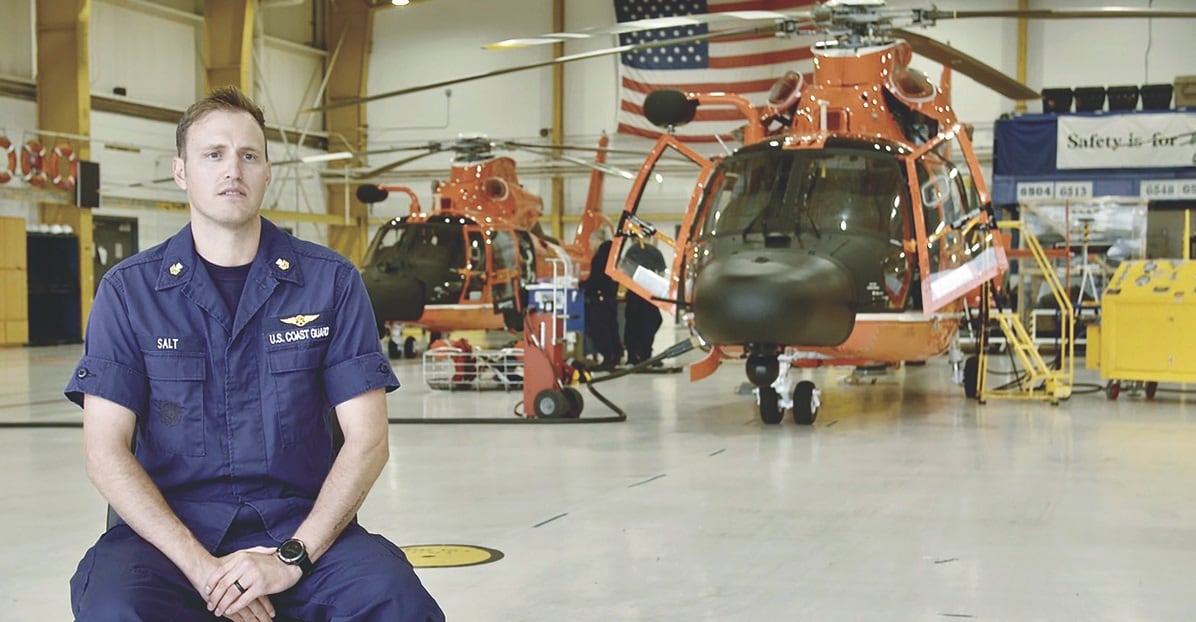The best part about being in the Coast Guard is having the opportunity to rescue people, according to Aviation Survival Technician 1 Trevor Salt.
“Being able to save a life, help someone out in a bad situation — that’s definitely the most rewarding,” Salt told Military Times.
Salt, 33, had the opportunity to do just that in January 2021, when he provided assistance to two hikers — including one who had suffered a severe fall — on Grayback Mountain in Oregon. According to his supervisor, the hikers would have almost certainly died had they not received help that night from Salt, who was an AST2 at the time.

For Salt, it was a completely new experience — and one that forced him to rely on all the training he had received as an aviation survival technician.
“I’d never stayed the night out on the mountain and had to use all the training that I’ve gone through for like survival schools, and building a shelter, and then providing prolonged field care,” Salt said. “So that was definitely the first time I had ever done something like that.”
Salt had just wrapped up a training flight in January, when Coast Guard Sector North Bend received an emergency call about hikers who were stuck in the mountains and required medical attention. Since the National Guard was unable to assist until the morning, Salt said the next step was to come up with various plans that the his commanding officer could sign off on so they could launch later that night.
Going into the night, the plan was to drop some hypothermic capsules to the hikers to keep them warm — and see if the helicopter was powerful enough, given the altitude, to hover and allow Salt to descend onto the mountain. Salt brought an EMT kit, a patient care monitor, along with his personal bag, totaling approximately 150 pounds of gear, he said.
Salt said he was hoisted down onto the mountain and headed to the injured, female hiker in her 40s approximately 100 feet away from him with ground crampons on his feet. Although the report initially said that woman had fallen approximately 50 feet and had a potential back injury, Salt said situations often are different upon arrival to the scene.
“When you’re flying out to go to a case your mind is just going through every possibility that you can think of...like injuries and you’re always thinking worst-case scenario,” Salt said. “And then once you get on scene it’s usually always completely different.”
As a result, Salt said he was very caught off guard when he learned she had actually fallen approximately 1,200 feet. But he found her oriented times four, a term used to describe a patient who knows their name, time, location, and why they are receiving help.
“She was alert and oriented times four, which going into a trauma patient, that’s really good news to have someone alert and oriented times four,” Salt said. “That means their brain’s still working, they still know what’s going on.”
Salt conducted an assessment of the injured hiker, bandaged up several lacerations on her head, and placed her in a C-collar before putting her in one of the hypothermic capsules, which are essentially large sleeping bags with access points for continued treatment. After splinting the arm of the injured hiker and placing her in another hypothermic capsule, Salt then started leveling out the snow so there was a working area and room for a shelter.
“So I put up a tarp across two trees down to the ground, and basically created a wind block from the wind,” he said. “And I made a little shelter for all three of us.”
Throughout the night, Salt said he kept the injured hiker awake and helped reposition her to alleviate pain.
Staying overnight was necessary because the Coast Guard’s MH-65 Dolphin helicopter is not powerful enough to hoist a person up in a litter, another person in a basket, plus an aviation survival technician. That meant they needed to wait until the National Guard could come evacuate them in a more powerful aircraft.
In the morning, Salt then leveled a hoisting platform, and also cleared a roughly 80-foot long pathway with the other hiker so the injured hiker could evacuate the scene in a litter.
Salt said he arrived on the mountain at approximately 11 p.m., and it wasn’t until about noon the next day that the National Guard arrived in an H-60 rescue helicopter.
“We definitely needed that 60 to be able to hoist all three of us out safely,” Salt said.
Although Salt has not had contact with the hikers he assisted, he said he has talked to the National Guard medic, who said the female hiker remained in the hospital for a week for fractured vertebrae, scapula, and some other minor injuries.
Salt has since been promoted to AST1, and he said his efforts to rescue the hikers played a role in the promotion. He also said he is aware that he has been written up for an award for his actions, but he isn’t sure which one at this time.
However, he said he has been selected for the Armed Services YMCA of the United States’ Angels of the Battlefield award, which is given to enlisted medical professionals from each branch of the military annually.
For other Coast Guardsmen who find themselves in a similar crisis, he recommends relying on one’s training to get through the situation.
“Just be ready and trained for worst-case scenario stuff,” Salt said. “You may think it’s never going to happen to you, but there’s always that possibility that you’re going to do everything that you’ve trained for.”
“Trust your training and stick with your training and your knowledge...training is really what you fall back on,” he said.




